Glory and Destruction in 1812
- "It had taken 12 years to create the cavalry that had ridden to Austerlitz, and six months to destroy it."
-- David Johnson
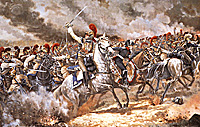 On 24 June, 1812 the carabiniers set-off on the ill-fated Russian campaign in new bronze cuirasses, red-crested helmets, and white uniforms. No longer under Nansouty, the carabiniers found themselves, in the extensive reshuffling prior to the invasion, assigned to Defrance's 4th Cuirassier (or Heavy) Division of General Montbrun's 2nd Reserve Cavalry Corps.
On 24 June, 1812 the carabiniers set-off on the ill-fated Russian campaign in new bronze cuirasses, red-crested helmets, and white uniforms. No longer under Nansouty, the carabiniers found themselves, in the extensive reshuffling prior to the invasion, assigned to Defrance's 4th Cuirassier (or Heavy) Division of General Montbrun's 2nd Reserve Cavalry Corps.
At right, Mark Churms' La Moskowa The Battle of Borodino. © M. Churms
Interestingly, their assignment seemed to indicate that they were no longer the senior line cavalry regiments. However, it may be simply that General Defrance, their former brigade commander, requested that they be a part of his new command.
In most units, the summer ride into the interior of Russia was as costly as the more famous winter retreat. Forage for the horses was pitiful. Disease played havoc on both man and beast. However, compared to the 1805 campaign, the carabiniers maintained their manpower strength better in 1812.
According to Vasilev, on 1 July, the 1st Carabinier Regiment consisted of 714 men, and the 2nd had 687 men. By 2 August, only 454 horses were remaining in the 1st and 407 in the 2nd. On 23 August, after the battle of Smolensk, the 1st Carabinier Regiment counted 494 men and 544 horses; the 2nd Regiment had 423 men and 483 horses.
Overall, from 1 July to 23 August, the two regiments had lost 35% of their effectives, but this loss rate was less for the carabiniers than it had been seven years earlier during the 1805 campaign when strategic consumption reduced the two regiments to less than 40% of their starting strength.
The increase in horses came primarily from acquiring inferior Russian mounts. The contrast between the large armored cavalrymen and the small Russian horses made for a ridiculous sight, but desperate measures were taken throughout this campaign.
At Borodino (7 September), the carabiniers would see their first real action of 1812. Montbrun's 2nd Cavalry Corps took up positions behind the French center. The battle commenced at dawn with a tremendous French artillery barrage. The focal point of the struggle in the middle would be the famous "Great Redoubt", a wood and dirt fortification that held 18 Russian artillery pieces and supporting infantry. During the course of the day's battle it would change hands four or five times in savage fighting, the area around it becoming a gruesome killing ground.
It was in support of this action against the Great Redoubt (or Raevski Redoubt) that the carabiniers would be committed. Montbrun and Defrance were ordered to attack the Russian cavalry deployed to the south of the redoubt as well as the infantry behind it. The carabiniers charged, coming against the Pernovski Infantry and a supporting Jaeger Regiment in square. According to Vasilev, the Russian infantry "allowed the cavalrymen to approach to the distance of 60 paces...and met them by deadly gun salvos. The attacking carabiniers stopped short, began to hesitate, then turned back and retreated to the initial position."
The carabiniers remained in a supporting position for most of the late morning. As they had been tormented at Aspern-Essling, again the two regiments suffered losses from the intense Russian artillery fire which characterized this particular battle. One of the casualties was the intrepid General Montbrun, killed by artillery fire from the Great Redoubt. He would be replaced by Napoleon's Imperial A.D.C. General Auguste Caulaincourt, who, at 2:00 p.m., received orders to support Prince Eugene's efforts to retake the Great Redoubt.
Caulaincourt bravely placed himself at the head of Wathier's cuirassier division of the 2nd Reserve Cavalry Corps, and attempted to ride around the Redoubt and take it from behind. Caulaincourt was killed in the attempt, and the cuirassiers were repulsed after a vicious struggle within the earthworks.
At right, Carabiniers and Napoleon reach Moscow. Sketch © Jacques deBreville.
The carabiniers charged and defeated these Russian light cavalrymen in the initial rush, but, near the end of their tether, the carabiniers were recalled as the hussars reformed and then pursued. At the end of this charge, the command of the 1st carabiniers was in the hands of a captain, all other officers being killed, wounded, or unhorsed.
Around this time, Saxon cavalry (namely the Saxon Garde du Corps) under General Thielemann breached the Great Redoubt in dramatic fashion, a rare feat for cavalry. (The French assigned the honor of capturing the Great Redoubt to the martyred General Caulaincourt and his French cuirassiers. Eventually, their Saxon allies received due credit, but the Caulaincourt myth persists.)
With the Redoubt finally in the hands of the Grande Armee, the battle wound down. The Russians suffered horrific losses, estimated at 50,000, or half of their army present on the field. The French suffered approximately 30,000 casualties, including 49 Generals. The 1st carabiniers lost 19 of 35 officers, or 54%, which indicates that the regiment probably lost 40-50% of its men, reducing its ranks to about 250 after the battle. The 2nd Regiment lost 11 of 35, or 31% of its officers killed and wounded, which extrapolates to an estimate of 270-300 effectives at the end of the day. Both commanding Colonels (Laroche and Blancard) received light wounds, but neither left the field.
During the disastrous retreat from Moscow, the two carabinier regiments ceased to exist as military formations. Only a handful of carabiniers made it across the Niemen River back to Poland with the remnants of the French army. Although they would be reformed and fight in the campaigns of 1813 and 1814, it would not be until the 1815 Waterloo campaign that the carabiniers would be worthy of their name and reputation again.
Like much of the Grande Armee in 1813, the carabiniers had to be rebuilt virtually from nothing. Napoleon's miraculous reconstitution of his once mighty army could only go so far. The Emperor could not find the proper mounts or enough physically imposing recruits to refit regiments like the carabiniers to their former standards, especially since he placed priority on rebuilding the Guard Cavalry first. Even worse, a critical shortage of cavalry officers made the task doubly difficult. While inexperienced masses of enthusiastic infantry (backed by quality artillery) might win battles, inexperienced and ill-fitted cavalry regiments could not exploit the victories such conscripts might provide.
On 25 April, the carabiniers were part of Wathier's 2nd Cuirassier Division of Count Sebastiani's 2nd Cavalry Corps. The 1st Regiment numbered just 6 officers and 85 troopers; the 2nd listed only 7 officers and 98 troopers (each "regiment" was less than the size of a squadron). The carabiniers took virtually no part in Napoleon's victories at Lutzen and Bautzen over the Russians and Prussians in the Spring of 1813.
During the Summer Armistice (of Pleischwitz), the Grande Armee was given the respite needed to augment and train the army's cavalry. Although the cavalry did not reach prior levels of ability or performance, Napoleon did manage to raise a sizable contingent of serviceable cavalry for the Fall campaign. However, Austria's decision to join the Allies tipped the balance of power against Napoleon once more.
On 25 August, after the armistice ended, the carabinier regiments numbered about 350 men each, with two squadrons per regiment. Sebastiani's Corps was detached to Macdonald's Army of the Bober. The carabiniers were present when the hapless Macdonald made his ill-advised attack on Marshal Blucher's Army of Silesia on 26 August (the same day Napoleon's main army won the battle at Dresden). Known as the battle of the Katzbach, the French rout shattered Macdonald's army. Apparently the carabiniers never got into the battle. Stranded on the other side of the swollen Katzbach River, they could only watch the panic and dissolution of nearly half of Macdonald's command.
Prior to the epic battle of Leipzig, the carabiniers received a third squadron each. Given the strategic consumption suffered by the regiments, this meant that the carabinier regiments were no more numerous than they had been on 25 August, when they had only two squadrons each.
At the five days of the battle for Leipzig, utilizing interior lines, Napoleon hoped to crush one of the Allied armies before the others could support it. On 16 October, the carabiniers participated in Napoleon's main offensive south at Wachau against the Army of Bohemia commanded by Austrian Prince Schwarzenberg.
As at Borodino, the highlight of the day was the charge of the Saxon Garde du Corps Cavalry, which spearheaded an assault that defeated General Pahlen's cavalry, then penetrated deep within the Allied lines, roughly handling grenadiers of the Russian Guard and temporarily capturing 26 guns. It is interesting to speculate how the Saxon cavalry, totally devastated in 1812, recouped to perform prodigies of valor again in 1813, while the carabiniers failed to live up to their former reputation.
The carabiniers performance at Wachau can only be called an embarrassment. David Johnson gives this account, based on the recollections of Rilliet, a member of the 1st Cuirassiers which was brigaded with the carabiniers in 1813. Rilliet begins:
"We were in column of regiments. The 1st carabiniers were in front and General Sebastiani was to the right of the regiment: all at once a mass of enemy cavalry, mainly Hungarian hussars, rode furiously down on the carabiniers. 'Bravo!' cried the general, laughing and waving the riding crop which was the only weapon that he deigned to use. 'This will be charming; hussars charging the carabiniers.'"
Johnson writes:
"Rilliet thought the huge carabinier troopers need only to draw their long swords to frighten the enemy away, but he was mistaken. When the Hungarians were 100 paces from them, the 1st carabiniers turned about and rode back on to the 2nd regiment; both regiments then fled....
At right, Detaille illustration of 1812 carabinier colonel.
During the retreat to the Rhine, an Austro-Bavarian force attempted to block the route of the Grande Armee. The battle of Hanau on 30 October culminated in the Imperial Guard attacking and breaking the Allied position. Sebastiani and the carabiniers were present and took part in the early action, but do not appear to have distinguished themselves.
The carabiniers crossed into France on 3 November along with the bedraggled remnants of Napoleon's last Grande Armee.
During the short campaign of France in 1814, the few carabiniers still mounted served at Montmirail (11 February), Vauchamps (14 February), Troyes (22 February), Laon and Craonne (9-10 March) and Rheims (13 March). Records and accounts are scarce for this campaign; while serving in the 2nd Heavy Cavalry division under General St. Germain, in Blancard's brigade, the carabiniers participated in Napoleon's great series of victories known as the Six Days Campaign in February, in which General Grouchy's conduct of the cavalry pursuit would eventually earn him a Marshal's Baton.
An Incident from the Restoration
During the first Bourbon Restoration after Napoleon's abdication in 1814, the carabiniers reverted to their ancien regime name of carabiniers de Monsieur. The much-reviled Comte d'Artois, one of the Napoleon's most implacable enemies, was appointed as the honorary colonel of the brigade. However, the formerly aristocratic carabiniers were not easily seduced by Bourbon efforts to ingratiate themselves with the new army. At one awards banquet given by the Comte for the regiment, the troopers' resentment became quite pronounced. Author David Johnson relates:
"Presiding over this festive occasion, M. le Comte, took the opportunity to toast the health of his two regiments; unfortunately, a member of his entourage, having drained his glass, hurled it to the ground in the traditional manner.
"The carabiniers immediately followed his example; then drawing their long swords they began laying about them on the tables and smashing everything in sight....the honorary colonel was lucky to escape injury."
It comes as no surprise that the carabiniers greeted Napoleon's return in 1815 with enthusiasm.
During the Hundred Days, the carabiniers were assigned to Kellermann's 3rd Cavalry Corps. They served in the 12th Cavalry Division under General Roussel d'Hurbal in Blancard's 1st Brigade. At the outset of the campaign, the 1st carabiniers numbered 434 men and officers, and the 2nd had 413 total. Each regiment was comprised of three squadrons.
The carabiniers did not take part in Kellermann's famous charge that day. Foolishly ordered to attack Wellington's center by Ney, Kellermann led Guiton's brigade of cuirassiers in yet another forlorn effort reminiscent of the use of French heavy cavalry in previous campaigns. Kellermann, the hero of Marengo, ordered these regiments to move out at a gallop, so that they would not have time to realize how desperate the odds were against them. Coming out of tall fields of grain, the cuirassiers surprised and overran the 69th British Regiment before it could close into square, taking one color, and chased off the 73rd and 33rd. But the charge was blasted back by artillery -- Kellermann had his horse shot out from under him and had to be rescued by hanging on to two other troopers' stirrups (much like some circus rider).
Two days later, at Waterloo, the carabiniers were positioned in the second line, awaiting the grand bombardment and preliminary attacks to wear down Wellington's infantry. From the commencement of the battle around noon, until after the debacle of d'Erlon's massed infantry assaults at about 2:30 p.m., the carabiniers waited for their moment.
Kellermann intended to hold out the carabiniers for a decisive stroke. During the short-lived Bourbon reign the carabiniers found time to acquire proper mounts, to reabsorb enough veterans and quality recruits, and to restore much of their former discipline and tactical skill. The carabiniers were once again imposing in appearance if not in ability.
The faults of Ney's cavalry assault at Waterloo are well-known. It was launched prematurely (around 3:30-4:00 p.m.) and then consumed virtually all of the French cavalry, which joined in the attack without Napoleon's consent. Perhaps the biggest blunder was that in an assault of 10,000 cavalry, no horse artillery was immediately present. This tactical error cannot be underestimated.
Kellermann's horse batteries had been detached to support the attacks of Jerome (Napoleon's younger brother) on the Chateau Hougoumont, while other horse batteries had been absorbed by the grand-battery. With neither infantry nor close artillery support, the French cavalry charged gallantly, as many as six or seven times, but could not break the resolute Allied squares. The muddy ground did nothing to help the cavalry retain any impetus.
The carabiniers were ordered in late in the event. The continuing friction between Kellermann and Ney, first evident at Quatre Bras, was exacerbated by Ney's insistence to reinforce failure. So the carabiniers went forward for their last charges under the eyes of the Emperor, led by Marshal Ney personally, who essentially stole them from Kellermann's command. With the ground before them now covered with dead horses, and the mud churned up and softened, the carabiniers achieved no real success, merely repeating the frustrating pattern of the cuirassiers. The brigade went bravely forward, maintaining discipline and order, but unable to exceed a trot.
Cut down by canister, shot at by infantry squares, Ney's impetuous cavalry attack was finally repulsed at approximately 6:00-6:15 p.m. The cavalry reserve of the Armee du Nord was a spent and disheartened force.
According to Scott Bowden's Armies at Waterloo, The 1st carabiniers lost 7 officers killed (including one squadron commander), 13 wounded, and 1 missing out of 32 officers present, for a loss rate of 72%. The 2nd carabiniers lost 1 officer killed and 11 wounded out of 30 officers present, or a loss rate of 40%. Furthermore, the 1st carabiniers commander, Colonel Roge was among the wounded, as was the brigade commander General Blancard.
On 26 June, eight days after Napoleon's last battle, the 1st carabiniers mustered only 136 officers and men, or 31% of their initial strength, and the 2nd carabiniers numbered just 195 officers and men, or 47% of their initial strength. Had Napoleon continued the 1815 campaign, the carabinier brigade would have fought on with the strength of barely one respectable regiment.
At right, 200mm bust of a carabinier general by Francois Verlinden.
In 1809, the carabiniers were again "damnably misused". Too often they were required to spend their courage and discipline in sacrificial charges to retrieve a bad situation or to stabilize a crisis. The heavy losses suffered at the hands of the Austrians greatly diminished the personnel of the brigade. By the campaign of 1812, the carabiniers appear to have declined somewhat in caliber even before their total destruction.
The partially rebuilt regiments of 1813-14 shared a name and a uniform with their predecessors, but, aside from a small cadre, little else remained of the two splendid carabinier regiments. In 1815, the incompetent waste of the brigade in its one action at Waterloo robs historians of a fair means of comparison.
It is somewhat ironic that the carabiniers are most remembered now for their distinctive uniforms. Their history is the story of excellent body of cavalry which paid a high price for less glory than they might have otherwise earned.
More Carabiniers
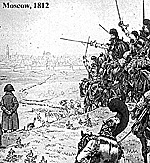 During this time, according to Manuscrit des carabiniers, the 1st Carabinier Regiment caught the Chevaliers Guard when the Russians presented their flank in attempting a tactical maneuver. Pursuing these cavalry, the 1st carabiniers encountered the Izumsky Hussar Regiment.
During this time, according to Manuscrit des carabiniers, the 1st Carabinier Regiment caught the Chevaliers Guard when the Russians presented their flank in attempting a tactical maneuver. Pursuing these cavalry, the 1st carabiniers encountered the Izumsky Hussar Regiment.
Unworthy of the Title in 1813-1814
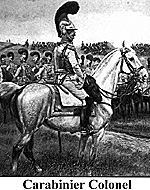 "When the fighting ended the carabiniers tried to take up quarters at a farm that was already occupied by the 5th Cuirassiers. The cuirassiers would not let them in. 'Pass on, carabiniers, there's nothing for you here,' they shouted. 'If you want hospitality, try the Hungarian hussars!'"
"When the fighting ended the carabiniers tried to take up quarters at a farm that was already occupied by the 5th Cuirassiers. The cuirassiers would not let them in. 'Pass on, carabiniers, there's nothing for you here,' they shouted. 'If you want hospitality, try the Hungarian hussars!'"
The Last Charges
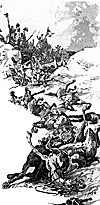 The carabiniers took part in the desperate battle of Quatre Bras on 16 June, where Marshal Ney took on the advance elements of Wellington's army. Squandering a numerical advantage that lasted much of the day, Ney finally launched a fierce but ill-coordinated series of attacks in the late afternoon. While Ney missed an opportunity to crush a portion of Wellington's force, Napoleon defeated Blucher's army only a short march away at Ligny.
The carabiniers took part in the desperate battle of Quatre Bras on 16 June, where Marshal Ney took on the advance elements of Wellington's army. Squandering a numerical advantage that lasted much of the day, Ney finally launched a fierce but ill-coordinated series of attacks in the late afternoon. While Ney missed an opportunity to crush a portion of Wellington's force, Napoleon defeated Blucher's army only a short march away at Ligny.
Opportunities Lost
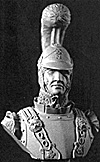 From 1805-1809, the carabiniers were indeed the finest line cavalry regiments of the French army. Yet, as their history indicates, the carabiniers never achieved the sort of battlefield successes that might be expected of their reputation; they had the misfortune to serve under one of the less capable battlefield commanders in Nansouty, and that "one glorious opportunity" never seemed to come their way.
From 1805-1809, the carabiniers were indeed the finest line cavalry regiments of the French army. Yet, as their history indicates, the carabiniers never achieved the sort of battlefield successes that might be expected of their reputation; they had the misfortune to serve under one of the less capable battlefield commanders in Nansouty, and that "one glorious opportunity" never seemed to come their way.
Carabiniers Section 1: 1679-1791
Carabiniers Section 2: 1792-1811
Carabiniers Section 3: 1812 and After
Carabiniers Uniforms 1801-09, 1810-15
Carabiniers Uniform Colors 1788-1815 (slow: 114K)
Carabiniers Postings: 1792-1815
Issue Cover: Carabiniers at Borodino (very slow: 224K)
Back to Table of Contents -- Napoleon #10
Back to Napoleon List of Issues
Back to MagWeb Master Magazine List
© Copyright 1997 by Emperor's Press.
This article appears in MagWeb (Magazine Web) on the Internet World Wide Web.
The full text and graphics from other military history magazines and gaming magazines are available at http://www.magweb.com